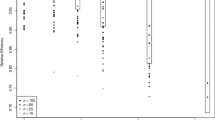Abstract
For discrete-time survival data, conditional likelihood inference in Cox’s hazard odds model is theoretically desirable but exact calculation is numerical intractable with a moderate to large number of tied events. Unconditional maximum likelihood estimation over both regression coefficients and baseline hazard probabilities can be problematic with a large number of time intervals. We develop new methods and theory using numerically simple estimating functions, along with model-based and model-robust variance estimation, in hazard probability and odds models. For the probability hazard model, we derive as a consistent estimator the Breslow–Peto estimator, previously known as an approximation to the conditional likelihood estimator in the hazard odds model. For the hazard odds model, we propose a weighted Mantel–Haenszel estimator, which satisfies conditional unbiasedness given the numbers of events in addition to the risk sets and covariates, similarly to the conditional likelihood estimator. Our methods are expected to perform satisfactorily in a broad range of settings, with small or large numbers of tied events corresponding to a large or small number of time intervals. The methods are implemented in the R package dSurvival.


Similar content being viewed by others
References
Allison PD (1982) Discrete-time methods for the analysis of event histories. Sociol Methodol 13:61–98
Andersen PK, Borgan O, Gill RD, Keiding N (1993) Statistical Models Based on Counting Processes. Springer, New York
Breslow NE (1974) Covariance analysis of censored survival data. Biometrics 30:89–100
Breslow NE (1981) Odds ratio estimators when the data are sparse. Biometrika 68:73–84
Buja A, Berk R, Brown L, George E, Pitkin E, Traskin M, Zhao L, Zhang K (2019) Models as approximations I: Consequences illustrated with linear regression. Stat Sci 34:523–544
Cochran WG (1954) Some methods for strengthening the common \(\chi ^2\) tests. Biometrics 10:417–451
Cox DR (1972) Regression models and life tables (with discussion). J R Stat Soc Ser B 34:187–220
Cox DR, Oaks DO (1984) Analysis of survival data. Chapman & Hall, London
Efron B (1977) The efficiency of Cox’s likelihood function for censored data. J Am Stat Assoc 72:557–565
Kalbfleisch JD, Prentice RL (1980) The statistical analysis of failure time data. Wiley, New York
Kaplan EL, Meier P (1958) Nonparametric estimation from incomplete observations. J Am Stat Assoc 53:457–481
Lin DY, Wei LJ (1989) The robust inference for the Cox proportional hazards model. J Am Stat Assoc 84:1074–1079
Lindsay BG (1980) Nuisance parameters, mixture models and the efficiency of partial likelihood estimators. Philos Trans R Soc Ser A 296:639–665
Lindsay BG (1983) Efficiency of the conditional score in a mixture setting. Ann Stat 11:486–197
Manski CF (1988) Analog estimation methods in econometrics. Chapman & Hall, New York
Mantel N, Haenszel WM (1959) Statistical aspects of the analysis of data from retrospective studies of disease. J Natl Cancer Inst 22:719–748
Peto R (1972) Contribution to the discussion of Cox (1972): regression models and life tables. J R Stat Soc Ser B 34:205–207
Prentice RL, Gloeckler LA (1978) Regression analysis of grouped survival data with application to breast cancer data. Biometrics 34:57–67
Robins JM, Breslow NE, Greenland S (1986) Estimators of the Mantel-Haenszel variance consistent in both sparse data and large strata limiting models. Biometrics 42:311–324
Tan Z (2020) Regularized calibrated estimation of propensity scores with model misspecification and high-dimensional data. Biometrika 107:137–158
Tan Z (2020b) dSurvival: discrete-time survival analysis, R package version 1.0. http://www.stat.rutgers.edu/~ztan
Tan Z (2022) Analysis of odds, probability, and hazard ratios: from 2 by 2 ables to two-sample survival data. J Stat Plan Inference 221:248–265
Therneau TM (2015) A Package for Survival Analysis, version 2.38
Therneau TM, Grambsch PM, Fleming TR (1990) Martingale based residuals for survival models. Biometrika 77:147–160
Therneau TM, Grambsch PM (2000) Modeling survival data: extending the Cox model. Springer, New York
Thompson WA Jr (1977) On the treatment of grouped observations in life studies. Biometrics 33:463–470
Tsiatis AA (1981) A large sample study of Cox’s regression model. Ann Stat 9:93–108
White H (1982) Maximum likelihood estimation of misspecified models. Econometrica 50:1–25
Willett JB, Singer JD (2004) Discrete-time survival analysis. In: Kaplan D (ed) SAGE handbook of quantitative methodology for the social sciences, pp 200–213
Author information
Authors and Affiliations
Corresponding author
Additional information
Publisher's Note
Springer Nature remains neutral with regard to jurisdictional claims in published maps and institutional affiliations.
Supplementary Information
Below is the link to the electronic supplementary material.
Rights and permissions
Springer Nature or its licensor (e.g. a society or other partner) holds exclusive rights to this article under a publishing agreement with the author(s) or other rightsholder(s); author self-archiving of the accepted manuscript version of this article is solely governed by the terms of such publishing agreement and applicable law.
About this article
Cite this article
Tan, Z. Consistent and robust inference in hazard probability and odds models with discrete-time survival data. Lifetime Data Anal 29, 555–584 (2023). https://doi.org/10.1007/s10985-022-09585-1
Received:
Accepted:
Published:
Issue Date:
DOI: https://doi.org/10.1007/s10985-022-09585-1




